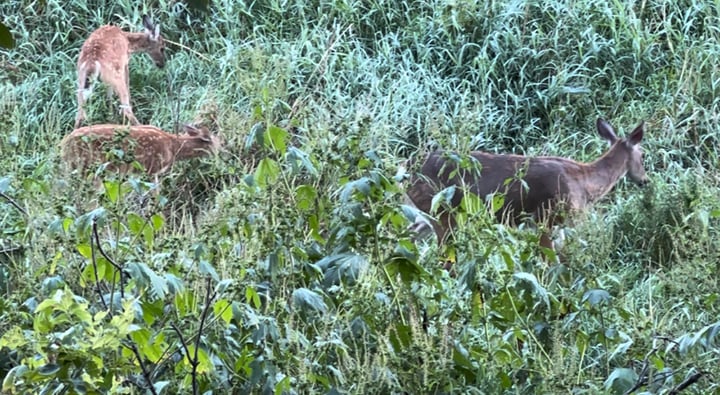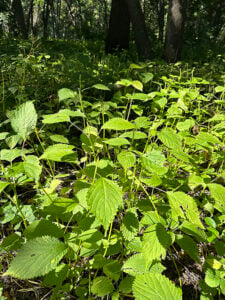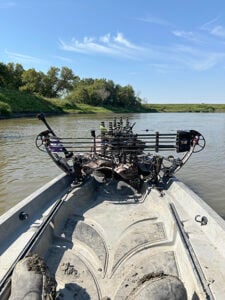Video: Key ingredients to upping your odds at success on early-season morning hunts – Outdoor News
I bumped a couple of bucks off their beds during a late-summer scouting trip two years ago. The weather and habitat conditions then were similar to what we typically see during the early archery season.
It was hot, with high humidity and temperatures in the 70s by early morning. My first goal was to find exactly where the biggest of the bucks was bedded.
Sure enough, it was in a location many bucks seem to prefer. A deadfall that arched over a low spot in the terrain created the ideal area for a whitetail to safely and comfortably hunker down. It featured great shade cover above, and the air was cooler there than it was in the surrounding area.
Fast forward to Sept. 1 of this year in North Dakota. I was set up in a tree 20 yards from that specific bed. About two hours after first light, a buck passed in front of me and bedded down in that exact spot. (Watch a video of the buck below.)
[embedded content]
It was a nice deer, but I was not quite ready for my season to end. Instead of shooting, I watched him bed down and lie there for a couple of hours. He eventually got to his feet and slowly grazed on green vegetation until he was out of sight.
It was a fun encounter that demonstrates what makes for ideal conditions during a morning hunt in the early archery season. A day later, a doe and two fawns fed by me for several minutes during another morning hunt in similar terrain.
There seems to be an unwritten rule in whitetail hunting that you don’t hunt mornings during the early season. This is predominantly big-buck related. The thought is that you won’t beat a buck back to its bed, and all you’ll do is pressure the deer with your presence.
MORE WHITETAIL COVERAGE FROM OUTDOOR NEWS:
Minnesota archers set to learn (non) winter’s effects on whitetails
Ryan Rothstein: Tips to make this your best deer-hunting season
Hunting a whitetails’ security cover: Here are keys to consistent success
This philosophy seems to last into mid-October, too. That same morning I had an encounter with a buck in North Dakota, a buddy of mine was watching through his spotting scope as a huge buck fed on soybeans an hour after daylight in South Dakota.
Hunting mornings during the early and midseason is certainly more difficult than doing so during the rut, when bucks are covering more ground. But it’s not a lost cause.
You can position yourself to have a chance at deer, including older bucks, during morning sits by focusing on a couple of things when hunting them.

Security areas with natural vegetation
The top priority is finding areas of security cover where deer feel safe while being on their feet during daylight.
The best of these areas have natural vegetation where deer are comfortable feeding throughout the day. This can be either directly in the bedding cover or near habitat transition where thicker security cover meets forbs or woody browse.

These “soft” edges are often much more subtle and harder to see than are “hard” edges, like where a field meets timber. But soft edges are great areas to focus your attention throughout the season.
Many times, I have seen bucks and does slip in and out these cover types, going back and forth from bedding to feeding right on the edge of the security cover. They are never more than a bound or two from being able to escape danger if need be.
In the example from above, it is leaves of ragweed and Canadian wood nettle (if my plant-identification app does not deceive me) that deer are feeding on.
Look for leaves being bitten off when examining plants. The giant ragweed stands about neck-high on deer in some places, and it offers both security and feeding opportunities.
There are areas in the woods where the tree canopy is not as thick, allowing sunlight to hit the forest floor. This is where you often find soft edges where lush vegetation grows a little higher than the surrounding cover.
These edges are great places to target all year, because they tend to provide both bedding and more palatable food options in the same general area.
Access is key

Once bedding areas are identified, hunting them effectively is made possible by having good access to your spot.
Is there a terrain feature that allows you to get to the area undetected? Sometimes the answer is no, but great access is what really makes a great location.
Think of ways you can enter through the “back door” while deer are feeding on a primary food source (ag crops, acorns, etc.) before coming back to the bedding area.
I often seek out areas with water so I can use hip boots, waders, or my kayak to get to a tree undetected. That’s how I was able to slip into the tree ahead of that buck Sept. 1.
My kayak was parked right behind me on the bank of the river, hidden from view. I walked up the bank and had about 15 feet before reaching the tree I had prepared.
Take a chance under the right conditions
Things will not go perfectly every time when hunting like this. You’ll bump some deer. You’ll get blown at by an alert doe. That’s hunting. It means you’re finding the areas where deer want to spend their time, and that’s a good thing.
Stay with it. Your hunt is not necessarily ruined by a doe that busts you early. Some of the best movement, even in the early season, often comes two or three hours after first light as deer get up from their first bed of the day to browse their way through the cover.







